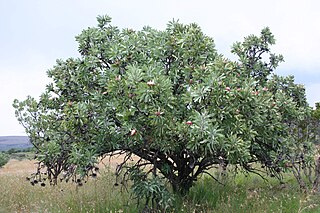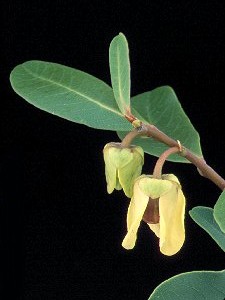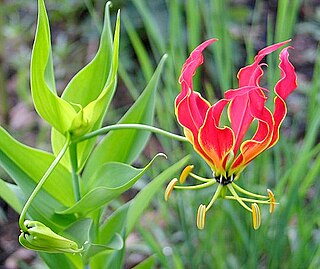
The Piperaceae, also known as the pepper family, are a large family of flowering plants. The group contains roughly 3,600 currently accepted species in 5 genera. The vast majority of peppers can be found within the two main genera: Piper and Peperomia.

Apocynaceae is a family of flowering plants that includes trees, shrubs, herbs, stem succulents, and vines, commonly known as the dogbane family, because some taxa were used as dog poison. Members of the family are native to the European, Asian, African, Australian, and American tropics or subtropics, with some temperate members. The former family Asclepiadaceae is considered a subfamily of Apocynaceae and contains 348 genera. A list of Apocynaceae genera may be found here.

Tulbaghia is a genus of monocotyledonous herbaceous perennial bulbs native to Africa, belonging to the Amaryllis family. It is one of only two known genera in the society garlic tribe within the onion subfamily. The genus was named for Ryk Tulbagh (1699–1771), one time governor of The Cape of Good Hope.

Carissa is a genus of shrubs or small trees native to tropical and subtropical regions of Africa, Australia and Asia. Until recently about 100 species were listed, but most of them have been relegated to the status of synonyms or assigned to other genera, such as Acokanthera.

Carissa spinarum, the conkerberry or bush plum, is a large shrub of the dogbane family (Apocynaceae), widely distributed in tropical regions of Africa, Southern Asia, Australia, and various islands of the Indian Ocean. It is most well known in Australia, where it is also called currant bush or, more ambiguously, native currant or even black currant. It is, however, neither closely related to plums (Prunus) nor to true currants (Ribes), which belong to entirely different lineages of eudicots. In India, it is also called wild karanda /wild karavanda, referring to the related karanda. Carissa spinarum is often discussed under its many obsolete synonyms.

Protea caffra, native to South Africa, is a small tree or shrub which occurs in open or wooded grassland, usually on rocky ridges. Its leaves are leathery and hairless. The flower head is solitary or in clusters of 3 or 4 with the involucral bracts a pale red, pink or cream colour. The fruit is a densely hairy nut. The species is highly variable and has several subspecies.

Carissa carandas is a species of flowering shrub in the family Apocynaceae. It produces berry-sized fruits that are commonly used as a condiment in Indian pickles and spices. It is a hardy, drought-tolerant plant that thrives well in a wide range of soils. Common names in English include Bengal currant, Christ's thorn, carandas plum and karanda.

Carissa macrocarpa is a shrub native to Southern Africa. It is commonly known as the Natal plum and, in South Africa, the large num-num. In Zulu, as well as in the Bantu tribes of Uganda, it is called Amathungulu or umThungulu oBomvu. In Afrikaans the fruit is called noem-noem.

Asimina tetramera, commonly known as the four-petal pawpaw, is a species of flowering plant endemic to the state of Florida. It is a small tree or large perennial shrub with one or more main stems. There is a total population count of about 950 plants, all of which are limited to areas in Martin and Palm Beach Counties in Florida. This is a federally listed endangered species of the United States.

Southern African Sand Forest is a sand forest, or a subtropical forest plant community of the tropical and subtropical dry broadleaf forests biome. It grows on ancient sand dunes in northern KwaZulu-Natal and southern Mozambique. In South Africa these forests are known simply as Sand Forest, while in Mozambique they are known as Licuati Forest. The Southern African sand forest is part of the Maputaland coastal forest mosaic ecoregion.

Gloriosa superba is a species of flowering plant in the family Colchicaceae. Common names include flame lily, climbing lily, creeping lily, glory lily, gloriosa lily, tiger claw, and fire lily.

Acokanthera oblongifolia is a plant in the family Apocynaceae. It grows as an evergreen shrub or small tree up to 6 metres (20 ft) tall. Its fragrant flowers feature a white tinged pink corolla. The berries are purple when ripe. Its habitat is dry forest and coastal thickets. Acokanthera oblongifolia is used in local African medicinal treatments for snakebites, itches and internal worms. The plant has been used as arrow poison. The species is native to Mozambique and South Africa.

Carissa bispinosa grows as a shrub or small tree up to 5 metres (16 ft) tall. Its fragrant flowers feature a white corolla. The fruit is red when ripe. Its habitat is woodland and forest from 1,080 m (3,540 ft) to 1,630 m (5,350 ft) altitude. Vernacular names for the plant include "forest num-num" and "Y-thorned carissa". Carissa bispinosa is native an area from Uganda to South Africa.

Leucospermum saxosum is an upright evergreen shrub of up to 2 m (6.6 ft) high, that is assigned to the family Proteaceae. It has lance-shaped, leathery leaves and egg-shaped flower heads of about 5 cm (2.0 in) in diameter, with initially yellow-orange flowers, later turning crimson, from which long styles stick out, giving the flower head the appearance of a pincushion. It is called escarpment pincushion in English. It grows on quartzite soils in the mountains on the Zimbabwe-Mozambique border and in eastern Transvaal.

Asimina reticulata, the netted pawpaw, is a species of plant in the family Annonaceae. It is native to Florida in the United States.

Actinidia tetramera is a species of flowering plant belonging to the family Actinidiaceae, that is native to Central China. It is a vigorous climber that can reach 8 m (26 ft) tall and broad. The ovate leaves are dark green with bright white flashes on the surface. The species is dioecious, meaning that male and female plants are separate. Fruit is only borne on a fertilised female plant.
Protea asymmetrica, also known as the Inyanga sugarbush, is a flowering plant, named for its asymmetric flowerheads, of the family Proteaceae and endemic to Zimbabwe and the Nyanga region, where it grows in grasslands, as well as Mount Nyangani.
Protea dracomontana, the Nyanga protea or the Drakensberg sugarbush, is a flowering plant that belongs within the genus Protea. The plant is found in the Eastern Cape, Lesotho, KwaZulu-Natal and the escarpment of the Free State, as well as eastern Zimbabwe. In Zimbabwe this species is only known from a disjunct subpopulation confined to the summit of Mount Nyangani.
Protea enervis, also known as the Chimanimani sugarbush, is a flowering shrub. It is native to the Chimanimani Mountains straddling Zimbabwe and Mozambique, and grows at altitudes of 1,680 to 2,000 metres.

Protea wentzeliana, also known as Wentzel's sugarbush, is a shrub belonging to the genus Protea.
















